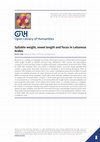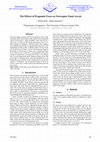Papers by Niamh Kelly

Glossa, 2021
Research on a variety of languages has shown that vowel duration is influenced by phonological vo... more Research on a variety of languages has shown that vowel duration is influenced by phonological vowel length as well as syllable structure (e.g., Maddieson 1997). Further, the phonological concept of a mora has been shown to relate to phonetic measurements of duration (Port, Dalby, & O'Dell 1987; Hubbard 1993; Cohn 2003). In Levantine Arabic, non-final closed syllables that contain a long vowel have been described as partaking in mora-sharing (Broselow, Chen, & Huffman 1997; Khattab & Al-Tamimi 2014). The current investigation examines the effect of vowel length and syllable structure on vowel duration, as well as how this interacts with durational effects of prosodic focus. Disyllabic words with initial, stressed syllables that were either open or closed and contained either a long or a short vowel were examined when non-focused and in contrastive focus. Contrastive focus was associated with longer words, stressed syllables and phonologically long vowels. Short vowels were shorter when in a syllable closed by a singleton but not by a geminate consonant, while long vowels were not shortened before coda singletons. An analysis is proposed whereby long vowels followed by an intervocalic consonant cluster are parsed as open syllables, with the first consonant forming a semisyllable (Kiparsky 2003), while long vowels followed by geminate consonants partake in mora-sharing (Broselow, Huffman, Chen, & Hsieh 1995). The results also indicate compensatory shortening for short vowels followed by a singleton coda.
Proceedings of Meetings in Acoustics, 2021
The production of stops in Lebanese Arabic and English was examined in monolingual mode and codes... more The production of stops in Lebanese Arabic and English was examined in monolingual mode and codeswitching mode. Voice onset time (VOT) was measured in word-initial voiced and voiceless stops for nine bilingual speakers and 12 monolingual Arabic speakers. Mixed model linear regressions found no significant difference in VOT between conditions (monolingual versus codeswitching), between languages (Arabic versus English), or between speaker groups (bilingual versus monolingual). The only significant predictor of VOT was voicing of the stops. These results show voicing during the closure for voiced stops and some aspiration for voiceless stops, with the same patterns found for bilingual speakers (in both languages) and monolingual speakers.

Proceedings of Meetings on Acoustics, 2021
The effect of phrase position on duration of words and segments, and its interaction with phonolo... more The effect of phrase position on duration of words and segments, and its interaction with phonological vowel length, was examined in Lebanese Arabic. Target words (disyllabic, initial stress) with either a phonologically long or short vowel in the stressed syllable were produced by six speakers (n=472). Words were produced in carrier sentences, where one was sentence-medial and one sentence-final, both under contrastive focus so as to control for that effect. Segment durations were measured. Results showed that stressed vowel duration was longer in phrase-final position but only when the vowel was phonologically long. Unstressed vowels were longer in phrase-final position, and were also longer when the stressed vowel was phonolog-ically short. Onsets were longer in phrase-medial position. These findings show an asymmetric effect of phrase position on vowel length, as well as an overall balancing of word duration by compensation between onsets and unstressed vowels. Published by the Acoustical Society of America
Research on Western Armenian has described it as having a contrast between voiceless aspirated st... more Research on Western Armenian has described it as having a contrast between voiceless aspirated stops and affricates, and voiced stops and affricates [1, 2]. The variety of Western Ar-menian spoken by a large population in Lebanon has not yet been examined phonetically, to determine the acoustic correlates of this contrast. The current study examines the alveolar and postalveolar affricates and alveolar stops (voiceless aspirated and voiced) in both word-initial and word-medial position , using nonsense words written in the Armenian script. The results indicate that voiced sounds have prevoicing, voiceless affricates have some aspiration, but voiceless stops have very short VOT, which aligns better with an analysis of them being classified as unaspirated. It was also found that position in the word does not affect VOT, duration of the closure or frication.

The Trøndersk dialect of East Norwegian is rather unusual typologically in that it exhibits a ton... more The Trøndersk dialect of East Norwegian is rather unusual typologically in that it exhibits a tonal contrast (unmarked vs. circumflex) on monosyllabic words . The goal of the current study was to examine this contrast and how it is impacted by sentential focus. Ten speakers of the Trøndersk dialect were recorded reading target monosyllabic words with these accents embedded in sentences with broad and narrow focus. In broad focus, words with the unmarked accent have an L tone and words with the circumflex accent have a HL contour with a higher F0 maximum and vowel onset than the unmarked contour. In narrow focus, both accents have a wider pitch range and later low tone alignment. Phonologically long vowels were lengthened under narrow focus. This study adds to the literature on the realization of focus in pitch accent languages, and the interaction between prosodically marked focus and lexical accents.

The lexical accents of one dialect of East Norwegian were examined using a parametric intonation ... more The lexical accents of one dialect of East Norwegian were examined using a parametric intonation model. The purpose of this investigation was to examine the tonal contrast using a different method, whereby analyses can be done automatically and additional acoustic cues examined. The disyllabic contrast of the Trøndersk dialect had been previously described using F 0 -measurements in Praat, but the current investigation uses a parametric intonation model, PaIntE . The results support the description of accent 1 and accent 2 having a HL contour, with accent 2 having a later alignment with the segmental string. Moreover, accent 2 was found to have a higher maximum and a smaller amplitude of the fall following the peak. The accents did not differ with respect to their rise or the steepness of the rise or fall. This research demonstrates how different approaches to linguistic analyses can inform one another.

The present paper examines the effect of pragmatic focus on the realisation of the lexical pitch ... more The present paper examines the effect of pragmatic focus on the realisation of the lexical pitch accent contrast in the Trøndersk variety of Norwegian. Target disyllabic words with accent 1 and accent 2 were read with broad and narrow focus by 10 native speakers of Trøndersk. Broad-to-narrow focus changes were implemented through an expanded pitch range and vowel lengthening for both accents. A different effect of focus on the two accents was also found. Accent 1 words had no change in the timing of tonal events in narrow focus compared to broad focus, while accent 2 words had a later alignment of the pitch contour in narrow focus. An unexpected H tone, a 'word-focus tone' was also found at the end of a number of target words. The results thus revealed that narrow focus affected pitch cues even though these are primarily used to distinguish the lexical pitch contrasts. Furthermore, the asymmetrical impact of focus on accent 1 and accent 2 words increases the distinction between two accents.
This paper examines the lexical tonal accent contrast in monosyllabic words in the Trøndersk dial... more This paper examines the lexical tonal accent contrast in monosyllabic words in the Trøndersk dialect of Norwegian. The results of a production experiment in which speakers produced the unmarked accent and the circumflex accent showed that the tonal distinction is characterised by a difference in f0 maximum, f0 height at onset, f0 minimum and its timing, and height of the final Accent Phrase H tone. The presence of the tonal accent contrast on monosyllabic words is unusual among dialects of Norwegian and Swedish.
This paper examines the acoustic characteristics that differentiate the four tones of Burmese: hi... more This paper examines the acoustic characteristics that differentiate the four tones of Burmese: high, low, creaky and stopped. The majority of previous work on Burmese tone is impressionistic but recently has become experimental . There are conflicting analyses of how the tones are distinguished. In particular, there is disagreement about the f0 contour of the high and low tones, the consistency of creakiness in the creaky and stopped tones, the role of f0 in distinguishing the creaky and stopped tones, and the vowel quality of the stopped tone.
The aim of this paper is to examine the importance of prosody in distinguishing two dialects of A... more The aim of this paper is to examine the importance of prosody in distinguishing two dialects of American English -a Southern dialect and a West Coast dialect. This was examined in a production study by comparing the intonation contours of the dialects, and in a perception study by determining whether listeners can distinguish the dialects on the basis of intonation contours.
Conference Presentations by Niamh Kelly
Tone and Intonation, 2021
This research provides insight into the interaction of a bilingual speaker's intonation patterns ... more This research provides insight into the interaction of a bilingual speaker's intonation patterns and hypercorrection. Perhaps intonation systems that differ between languages are particularly salient to a learner?
This research provides insight into the phonology of syllable weight in Arabic by providing quant... more This research provides insight into the phonology of syllable weight in Arabic by providing quantitative evidence that questions previous assumptions about mora-sharing in VVC rimes.









Uploads
Papers by Niamh Kelly
Conference Presentations by Niamh Kelly